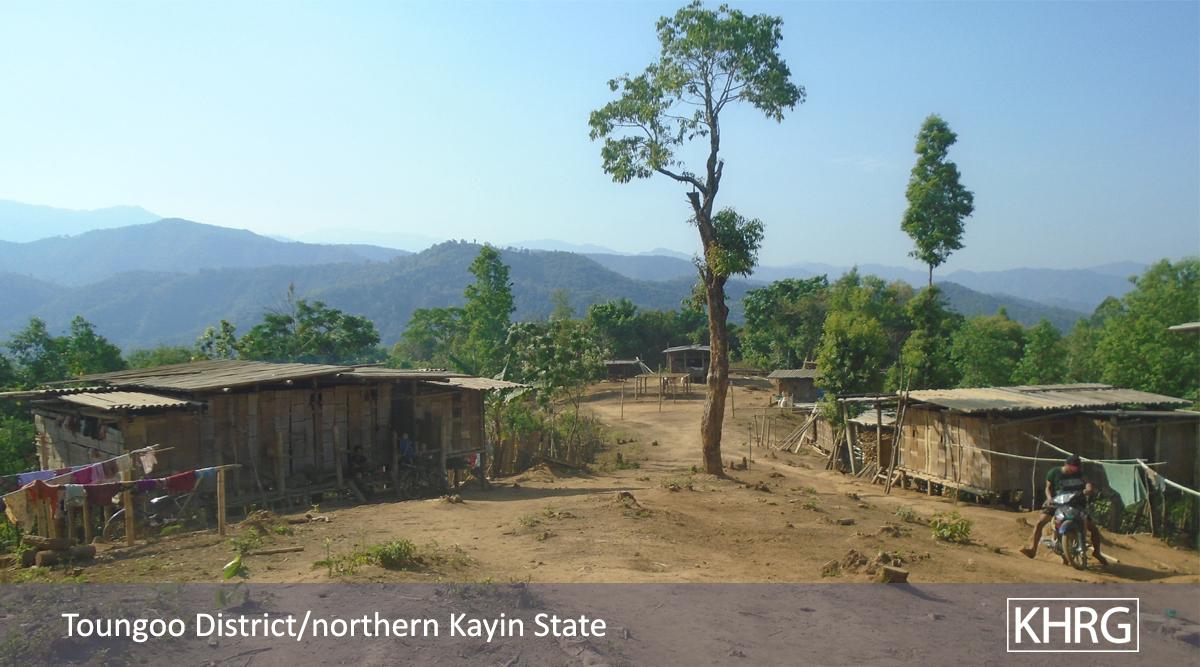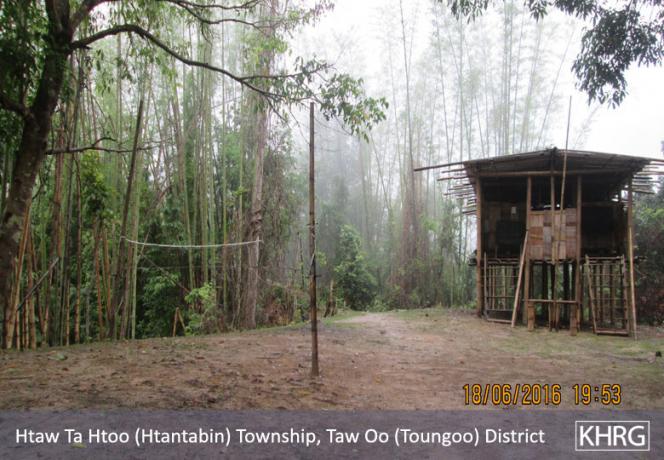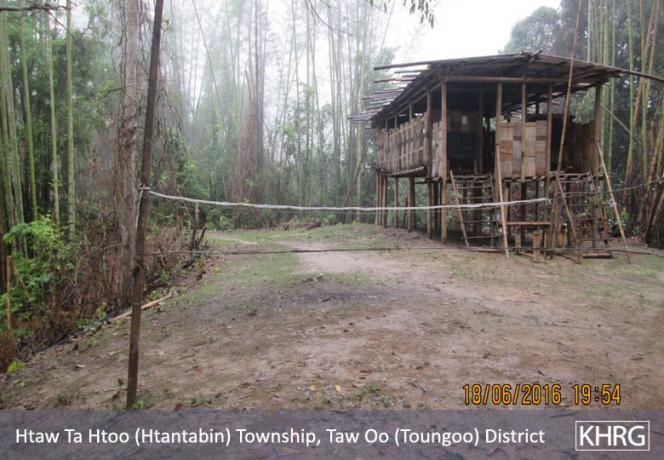This Situation Update describes events occurring in Htantabin Township and Thandaunggyi Township, Toungoo District during the period between June and October 2016, including education, livelihood, development projects by companies and arbitrary land confiscation.
- IDP children faced difficulty accessing education prior to Nationwide Ceasefire Agreement (NCA). After the NCA was signed, the IDPs who sought refuge at Ei Tu Hta (IDP Camp) have returned to their original homes and IDP children can now resume their education.
- From June to October 2016, villagers from Toungoo District, faced difficulties because the harvest for plantations such as cardamom and durian was delayed this year due to abnormal weather conditions.
- The Myanmar government gave permission to four companies, Ye Thu Ya Company, Yadanar Kyaw Company, Aung Myint Mo Company and Alpha (Power Engineering) Company, to build an electricity factory (Baw G’ Lee Electric Power Sub-plant) in Kler Lar village, Htantabin Township, Toungoo District.
Situation Update | Htantabin Township and Thandaunggyi Township, Toungoo District (June to October 2016)
The following Situation Update was received by KHRG in November 2016. It was written by a community member in Toungoo District who has been trained by KHRG to monitor human rights conditions. It is presented below translated exactly as originally written, save for minor edits for clarity and security.[1] This report was received along with other information from Toungoo District, including five interviews, 213 photographs and 6 video clips.[2]
Introduction
This situation update describes events occurring in Thandaunggyi Township and Htantabin Township, Toungoo District during the period between June and October 2016, including education, livelihood, development projects by companies and arbitrary land confiscation.
Education
The [education] situation has changed within Taw Oo [Toungoo] District since the Nationwide Ceasefire Agreement [NCA][3] was signed [in 2015]. Before the NCA was signed, children in IDP areas did not have proper schools and were facing barriers with getting access to education.[4] But after the NCA was signed, the IDPs who sought refuge in Ei Tu Hta [IDP Camp] were able to return to their homes, which gave [the children] a chance to study properly. The IDPs from Ei Tu Hta IDP Camp returned to two areas in Taw Oo District and restored their [previous] schools and houses. Some schools, which were built by the Karen National Union [KNU], were restored without outside support; however, these schools continue to use the Karen Education Department [KED][5] curriculum. After the students complete primary school [Standard Four], they continue their studies at Htoe Lwee Wah [High] School in Taw Oo [Toungoo] District, starting from Standard Five.
Livelihood
There are two townships in Taw Oo [Toungoo] District: Daw Hpa Hko [Thandaunggyi] Township and Htaw Ta Htoo [Htantabin] Township. In these two townships, villagers from Daw Hpa Hko Township mostly secure their livelihood by working on plantations whereas villagers in Htantabin Township secure their livelihood by doing both highland and lowland agricultural work. In highland areas, villagers mostly grow cardamom, durian, coffee, dog fruit and betel nut. In lowland areas, villagers are mostly farming.
Between June and October 2016, villagers from Taw Oo District, especially [villagers from] Htaw Ta Htoo Township, faced difficulties because abnormal weather this year caused delayed harvests for plantations such as cardamom and durian. In fact, cardamom was harvested in September last year but was harvested in October this year so villagers [who work on those plantations] faced difficulties due to the late harvests.
Development by Companies
There are four companies that secured permission from the Burma/Myanmar government to conduct development [projects] in Kler Lar village, Htaw Ta Htoo Township, Taw Oo District. The purpose of this development project was to establish an electricity factory known as the Baw G’ Lee Electric Power Sub-plant. The four companies involved in establishing this electric power sub-plant were: Ye Thu Ya [YTY] Company, Yadanar Kyaw Company, Aung Myint Mo Company, Elpar Company.
Kyaw Kyaw Min, one of the electricity officers, took responsibility [for implementing the project] in the area of Kler Lar. We [KHRG researchers] conducted an interview with him [Kyaw Kyaw Min] about the electric power sub-plant on March 13th 2016.
These four development companies were each responsible for their own separate part of the [electric power sub-plant] project. YTY took responsibility to distribute to villagers electricity (400 Voltage), transmission line (11000), and power line (33 KV).
Regarding the Baw G’ Lee Electric Power Sub-plant, the YTY director named Ko[6] Thu Ra would distribute [electricity] to the villagers of Kler Lar (Baw G’ Lee), Kaw Thay Der, Kler Soe Hkee, and Ler Khoe villages. Baw G’ Lee Electric Power Sub-plant would be distributed to Thay Say Taung, Pyaung Tho, and from Baw G’ Lee to Sapakyi (Pel Kaw Der) villages.
The Yadanar Kyaw Company [took responsibility] to distribute electricity (400 Voltage) to Thit Say Taung, Pyaung Tho, Kyauk Pone, Yay Tho Lay, Yay Tho Gyi, Sapakyi villages. Aung Myint Mo Company, directed by Ko Yin Thway, managed the 33 KV power line. He took responsibility to distribute electricity along the 21.4 miles to Baw G’ Lee. Elpar Company took responsibility for [managing the] electric power sub-plant.
Land Confiscation
Villagers report livelihood challenges due to land confiscation in A--- village, Kwun Pin village tract,[7] Htantabin Township, [Toungoo Township], Bago Region. Specifically, due to the construction of a dam by the Burma/Myanmar government, residents of B--- village and C--- village were forced to leave and abandon their homes within three days [due to the imminent destruction of B--- village and C--- village]. Since the beginning of 1993, these villagers [from B--- village and C--- village] have faced constant difficulties and struggles to secure their livelihoods.
Footnotes:
[1] KHRG trains community members in southeast Burma/Myanmar to document individual human rights abuses using a standardised reporting format; conduct interviews with other villagers; and write general updates on the situation in areas with which they are familiar. When writing situation updates, community members are encouraged to summarise recent events, raise issues that they consider to be important, and present their opinions or perspective on abuse and other local dynamics in their area.
[2] In order to increase the transparency of KHRG methodology and more directly communicate the experiences and perspectives of villagers in southeastern Burma/Myanmar, KHRG aims to make all field information received available on the KHRG website once it has been processed and translated, subject only to security considerations. For additional reports categorised by Type, Issue, Location and Year, please see the Related Readings component following each report on KHRG’s website.
[3] On October 15th 2015, after a negotiation process marred with controversy over the notable non-inclusion of several ethnic armed groups and on-going conflicts in ethnic regions, a Nationwide Ceasefire Agreement (NCA) was signed between the Burma/Myanmar government and eight of the fifteen ethnic armed groups originally invited to the negotiation table, including the KNU, see “Myanmar signs ceasefire with eight armed groups,” Reuters, October 15th 2015. The signing of the NCA followed the January 12th 2012 preliminary ceasefire agreement between the KNU and Burma/Myanmar government in Hpa-an. For KHRG's analysis of changes in human rights conditions since the preliminary ceasefire, see Truce or Transition? Trends in human rights abuse and local response since the 2012 ceasefire, KHRG, May 2014, “Ongoing militarisation in southeast Myanmar,” KHRG, October 2016 and “Dooplaya Field Report: A quasi-ceasefire? Developments after the Nationwide Ceasefire Agreement, from January to December 2016,” KHRG, September 2017.
[4] For more information on barriers to accessing healthcare during this time see Chater 3: Education in “Foundation of Fear: 25 years of villagers’ voices from southeast Myanmar,” KHRG, October 2017.
[5] The Karen National Union's Education Department. The main goals of the KED are to provide education, as well as to preserve Karen language and culture. During the civil war in Burma/Myanmar the KED became the main organisation providing educational services in the KNU controlled areas in southeast Burma/Myanmar. The KED also previously oversaw the educational system in the seven refugee camps along the Thai-Burma/Myanmar border, however in 2009 these activities were restructured under the Karen Refugee Committee – Education Entity (KRCEE). See "Conflict Erupts over Govt teachers deployed to KNU areas," Karen News, August 20th 2013 and the KRCEE website: "About," accessed July 21st 2015.
[6] Ko is a Burmese title meaning older brother. It can be used for relative as well as non-relative.
[7] A village tract is an administrative unit of between five and 20 villages in a local area, often centred on a large village.









